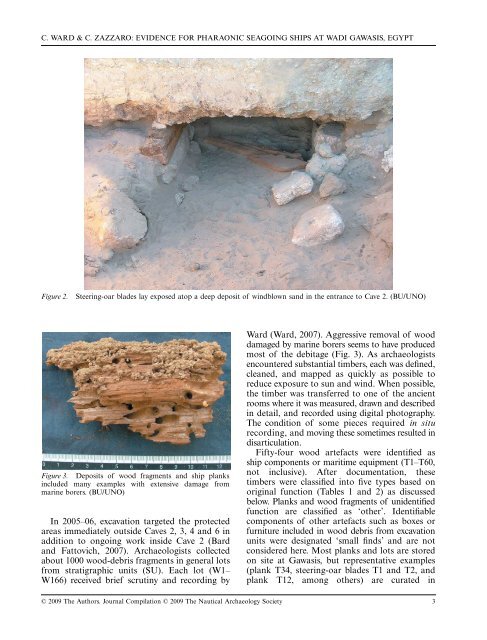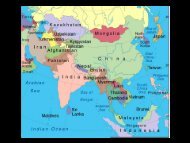Evidence for Pharaonic Seagoing Ships at Mersa/Wadi Gawasis ...
Evidence for Pharaonic Seagoing Ships at Mersa/Wadi Gawasis ...
Evidence for Pharaonic Seagoing Ships at Mersa/Wadi Gawasis ...
You also want an ePaper? Increase the reach of your titles
YUMPU automatically turns print PDFs into web optimized ePapers that Google loves.
C. WARD & C. ZAZZARO: EVIDENCE FOR PHARAONIC SEAGOING SHIPS AT WADI GAWASIS, EGYPT<br />
Figure 2. Steering-oar blades lay exposed <strong>at</strong>op a deep deposit of windblown sand in the entrance to Cave 2. (BU/UNO)<br />
Figure 3. Deposits of wood fragments and ship planks<br />
included many examples with extensive damage from<br />
marine borers. (BU/UNO)<br />
In 2005–06, excav<strong>at</strong>ion targeted the protected<br />
areas immedi<strong>at</strong>ely outside Caves 2, 3, 4 and 6 in<br />
addition to ongoing work inside Cave 2 (Bard<br />
and F<strong>at</strong>tovich, 2007). Archaeologists collected<br />
about 1000 wood-debris fragments in general lots<br />
from str<strong>at</strong>igraphic units (SU). Each lot (W1–<br />
W166) received brief scrutiny and recording by<br />
Ward (Ward, 2007). Aggressive removal of wood<br />
damaged by marine borers seems to have produced<br />
most of the debitage (Fig. 3). As archaeologists<br />
encountered substantial timbers, each was defined,<br />
cleaned, and mapped as quickly as possible to<br />
reduce exposure to sun and wind. When possible,<br />
the timber was transferred to one of the ancient<br />
rooms where it was measured, drawn and described<br />
in detail, and recorded using digital photography.<br />
The condition of some pieces required<br />
in situ<br />
recording, and moving these sometimes resulted in<br />
disarticul<strong>at</strong>ion.<br />
Fifty-four wood artefacts were identified as<br />
ship components or maritime equipment (T1–T60,<br />
not inclusive). After document<strong>at</strong>ion, these<br />
timbers were classified into five types based on<br />
original function (Tables 1 and 2) as discussed<br />
below. Planks and wood fragments of unidentified<br />
function are classified as ‘other’. Identifiable<br />
components of other artefacts such as boxes or<br />
furniture included in wood debris from excav<strong>at</strong>ion<br />
units were design<strong>at</strong>ed ‘small finds’ and are not<br />
considered here. Most planks and lots are stored<br />
on site <strong>at</strong> <strong>Gawasis</strong>, but represent<strong>at</strong>ive examples<br />
(plank T34, steering-oar blades T1 and T2, and<br />
plank T12, among others) are cur<strong>at</strong>ed in<br />
© 2009 The Authors. Journal Compil<strong>at</strong>ion © 2009 The Nautical Archaeology Society 3







